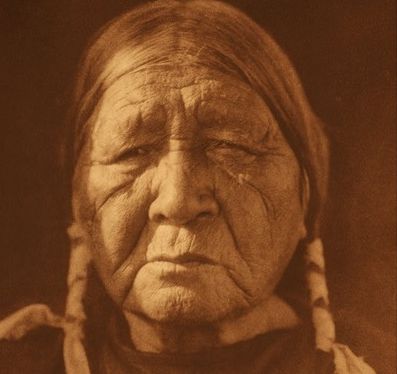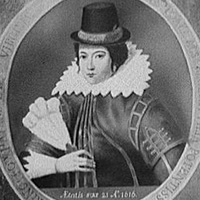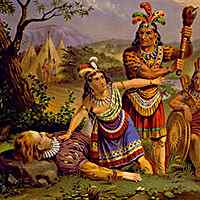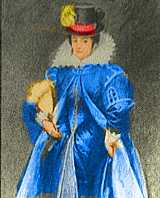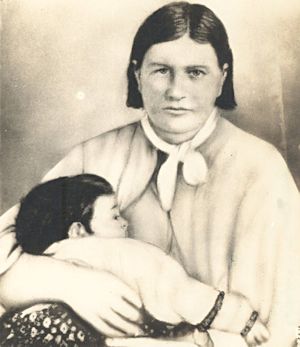Hanging Cloud was the so-called “Chippewa Princess” who was renowned as a warrior and as the only female among the Chippewa allowed to participate in the war ceremonies and dances, and to wear the plumes of the warriors.
Native American Women
Dolly Akers or Dolly Smith Cusker Akers (March 23, 1901 – June 5, 1986) – First woman elected to the Tribal Executive Board of the Assiniboine and Sioux Tribes on the Fort Peck Indian Reservation and the first Native American elected to the Montana Legislature.Tammie Allen – (born 1964) – Apache Potter.
Allaquippa – A Delaware woman sachem of this name lived in 1755 near the mouth of Youghiogheny River, Allegheny County, Pennsylvania, and there may have been a small Delaware settlement known by her name.
Ahshahwaygeeshegoqua (The Hanging Cloud) – The so-called “Chippewa Princess” who was renowned as a warrior and as the only female among the Chippewa allowed to participate in the war ceremonies and dances, and to wear the plumes of the warriors.
Annie Antone – Tohono O’odham contemporary, pictorial basketweaver.
Barbara Bartleson – Navajo/Jicarilla Apache actress.
Irene Bedard – Iñupiaq-Cree Actress, Voice Artist, Singer
Heidi Bigknife -Shawnee jeweler/silversmith.
Buffalo Calf Robe (aka Calf Trail Woman): Buffalo Calf Robe performed one of the greatest acts of valor in the 1876 battle of the Rosebud in Montana (in which U.S. troops commanded by General Crook, along with their Crow and Shoshone allies, fought against the Cheyenne and Lakota Sioux). The Shoshone and Crow shot the horse of Cheyenne Chief Comes in Sight out from under him. As the warriors were closing in to finish him off, Buffalo Calf Robe, the chief’s sister, rode into the middle of the warriors and saved the life of her brother.
Buffalo Calf Road Woman – Cheyenne. Wife of Black Coyote. Sister of Comes In Sight. Later renamed Brave Woman after Custer’s Last Stand battle. Also see Black Coyote.
Yvonne Chouteau – Former Shawnee prima ballerina.
Mildred Imoch Cleghorn – (Eh-Ohn and Lay-a-Bet) (December 11, 1910 – April 15, 1997) One of the last Chiricahua Apaches born under a “prisoner of war” status. She was an educator and traditional doll maker, and was regarded as a cultural leader. First tribal chairman of the Fort Sill Apache tribe.
Colestah – Colestah was a famed Yakama medicine woman, psychic and warrior. Armed with a stone war club, she rode into battle with her husband, Yakama leader Kamiakin, and fought at his side. In the 1858 battle of Spokane Plains in Washington, Kamiakin was nearly killed when a howitzer shell hit a tree and the tree branch knocked him from his horse. Colestah rescued him and then used her healing skills to cure him.
Samantha Crain (b. 1986) – Apache singer/songwriter, musician
Nora Thompson Dean (Touching Leaves Woman, 1907–1984) – Traditionalist, herbalist, and language instructor.
Ella Carla Deloria (Anpetu Wastewin) (1888-1971)- Yankton Sioux Author.
Karen Louise Erdrich, Author
Louise Erdrich – German/Chippewa known for her moving and often humorous portrayals of Chippewa life in North Dakota in poetry and prose.
Ella Carla Deloria (Anpetu Wastewin), Yankton Sioux (1888-1971), Author
Fallen Leaf (often called Woman Chief by the Americans) – Though Fallen Leaf became famous as a Crow warrior, she was actually born to the Gros Ventre nation and was captured by the Crow when she was 12. After she had counted coup four times in the prescribed Crow tradition, she was considered a chief and sat in the council of chiefs. In addition to being a war leader, she was also a good hunter and had two wives.
Elena Finney – Mescalero-Apache, Mexican Tarascan Indian and Irish actress.
Gouyen, (meaning “Wise Woman”) – Apache warrior. Gouyen was born into Chief Victorio’s Warm Springs Apache band around 1880. One day, while the group was resting at Tres Castillos, New Mexico, it was attacked by Mexicans. When the offensive was over, seventy-eight Apaches had been murdered and only seventeen had escaped, including Gouyen and her young son, Kaywaykla. Her baby daughter, however, was murdered and shortly afterwards her husband was killed in a Comanche raid while visiting the Mescalero Apaches. A legendary tale is told about the revenge of Gouyen. One night following her husband’s death, she put on her buckskin puberty ceremony dress and left the camp carrying a water jug, dried meat, and a bone awl and sinew for repairing her moccasins. She was looking for the Comanche chief who had killed her husband. Finally, she found him engaged in a Victory Dance around a bonfire with her husband’s scalp hanging from his belt. Gouyen slipped into the circle of dancers, seduced the chief, and killed him, avenging her husband’s death. Then she scalped him, cut his beaded breechcloth from his body and tore off his moccasins. She then returned to her camp to present her in-laws with the Comanche leader’s scalp, his clothing and his footwear. Gouyen remarried an Apache warrior named Ka-ya-ten-nae. Later, she and her family were taken prisoner by the U.S. Army and held at Fort Sill, Oklahoma, where she died.
Indian Hannah, aka Hannah Freeman (1730–1802) – Was said to be the last of the Lenni-Lenape Indians in Chester County, Pennsylvania.
Joy Harjo (b. 1959) – Muscogee-Cherokee poet and jazz musicianSuzan Shown Harjo (b. 1945) – Muscogee-Cheyenne activist, policymaker, journalist, and poet.LaDonna Harris (born 1931) – Comanche political activist and founder of Americans for Indian Opportunity.Viola Hatch – Cheyennne activist, policymaker, tribal elder, past tribal chair.Rosella Hightower (1920–2008) – Apache prima ballerina.
Joan Hill (b. 1930) – Muscogee-Cherokee artist.
Ruthe Blalock Jones – Shawnee painter and arts educator.
Helen Lydia Kamakaʻeha a.k.a. Liliʻuokalani Kawānanakoa (1905–1969) – Was a member of the House of Kawānanakoa and the second daughter of Hawaiian Prince David Kawānanakoa. Known by many in the Hawaiian community as Princess Liliuokalani, although she never officially held such a title.Yvonne Kauger – Cheyenne. Oklahoma Supreme Court Justice.
Geraldine Keams – Navajo actress, writer, and storyteller.
Wonzie Klinekole – Enrolled member of the Mescalero-Apache tribe. She’s Mescalaro-Apache/Kiowa-Apache/Comanche. Actress. “Rays of the Sun,” on Walker, Texas Ranger as Emily Red Hawk in #Plague.Susan La Flesche, Sioux (1865-1915)
Magdelaine Laframboise – Odawa-French fur trader and businesswoman, also supported public education for children on Mackinac Island; added in 1984 to Michigan’s Women’s Hall of Fame.
Sacheen Littlefeather – 947-, Apache/Yaqui/Pueblo actress and activist.
TV Slur Revives Debate About Sacheen Littlefeather and Her Role in Marlon Brando’s Oscar Refusal
Valentina Firewalks Lopez – Mescalero Apache Actress. Stars in Bonnie Looksaway’s Iron Art Wagon.Mildred Loving – In 1967, Mildred Loving and her husband Richard successfully defeated Virginia’s ban on interracial marriage via a famed Supreme Court ruling that had nationwide implications.
Lozen – She was born into the Chihenne, Warm Springs Apache band, during the late 1840’s. She was the sister of Chief Victorio and a skillful woman warrior, a prophet, and an outstanding medicine woman. Victorio is quoted as saying, “Lozen is my right hand, strong as a man, braver than most, and cunning in strategy. Lozen is a shield to her people.”
Legend has it that Lozen was able to use her powers in battle to learn the movements of the enemy and that she helped each band that she accompanied to successfully avoid capture. After Victorio’s death, Lozen continued to ride with Chief Nana, and eventually joined forces with Geronimo’s band, eluding capture until she finally surrendered with this last group of free Apaches in 1886. She died of tuberculosis at the Mount Vernon Barracks in Mobile, Alabama.
Maa-ya-ha (Grandmother Nellie) – The maternal grandmother of Ernestene Cody Begay, Maa-ya-ha, was born around 1879 into the band of Western Apaches living near Cibecue Creek. She knew a great deal about herbs, was an accomplished basket weaver, farmer and midwife. She also served as an attendant during many Sunrise Dances. Maa-ya-ha had ten children with her husband, Eskin-na-chik.
Renae Morriseau – Saulteaux/Cree actress.
Moving Robe: One of the best-known battles in the annals of Indian-American warfare is the 1876 Battle of the Greasy Grass in Montana, where Lt. Col. George Armstrong Custer was defeated. One of those who lead the counterattack against the cavalry was the woman Tashenamani (Moving Robe).
Mary Musgrove (ca. 1700–1765) served as a cultural liaison between colonial Georgia and the Muscogee Creek community.
Lilakai Julian Neil – First woman elected to Navajo Tribal Council (1946–1951)
Nonhelema (1720–1786) – Sister of Cornstalk, helped compile the dictionary for the Shawnee language.
Daphne Odjig (b. 1919), Ottawa Woodlands style painter and member of the Indian Group of Seven.
Cynthia Ann Parker – A white captive who was captured by the Comanche as a young girl and became the wife of a Comanche chief. She was the mother of Quanah Parker. Many years later she was “rescued” by whites, and spent the rest of her life trying to get back to her Comanche people. Also see Cynthia Ann Parker BioPatricia Phillips – Apache, Seneca, Deleware aerospace reporting and feature writing.
Pocahontas
Pocahontas Profile for Kids
Pocahontas, Pamunkey(1595?-1617)
Queen Anne, Pamunkey(ca. 1650-ca. 1725)
Anna Price (Her Grey eyes) – (1837-1937) She was the eldest daughter of Diablo, one of the most influential chiefs of the White Mountain Apache.
Jereldine “Jeri” Redcorn, aka Bah-ha Nutte, (meaning “River Woman) (born 1939-) – A Caddo-Potawatomi artist who single-handedly revived traditional Caddo pottery.Odilia Galvan Rodriguez – Apache writer and human rights activist.
Joanelle Romero – An actress of Apache/Cheyenne descent.Running Eagle: She became a Blackfoot (Piegan) warrior after her husband was killed by the Crow. To avenge her husband’s death, she sought help from the Sun and was told “I will give you great power in war, but if you have intercourse with another man you will be killed.” After this she became a very respected war leader and led many successful raids on the large Flathead horse herds west of the Rocky Mountains. She was killed on a raid in Flathead country. As legend goes, she had had sexual relations with one of the men in her war party, and for this reason had lost her war power.
Sanapia (1895–1984) – Comanche medicine woman.
Clara Nezbah Sherman – Navajo weaver.
Gail Small – A Northern Cheyenne activist and attorney.
Cynthia Leitich Smith (b. 1967) Muskogee children’s book author, noted Jingle Dancer.
Jeannine Stalling – Cheyenne activist.
Mrs. Andrew Stanley – (1866-?) A White Mountain Apache who had her personal narrative published in the book Apache Raiding and Warfare , edited by Keith H. Basso. In this book, she tells of her daring escape from Fort Apache in Arizona in the late 19th century. This narrative also tells of her hardships in rejoining her people.DR. ELOISA GARCIA TAMEZ – Lipan Apache human rights defender, and the only Native American woman and individual to counter-sue the U.S. Department of Homeland Security, the U.S. Army, and the U.S. Customs Border Patrol against the construction of the U.S. border wall, in Tamez v. Michael Chertoff et al. To this day she staunchly defends Aboriginal Title of Lipan Apaches, and challenges the U.S. claims to sovereignty in Indigenous lands and over Indigenous Nations in the U.S. courts and in the Inter-American Commission/Organization of American States.Maria Tallchief – Osage professional Ballerina.
Margo Tamez – (1962-) White Mountain Apache, Jumano Apache, Lipan Apache. Activist, poet, author,community historian, educator.
Luci Tapahonso – Navajo poet and lecturer.
Lucy Thompson (1856–1932) – Yurok and first indigenous Californian woman to be published.
Minnie Two Shoes (1950—2010) – Journalist, activist, publicist for the American Indian Movement, and co-founder of the Native American Press Association.Carrie Underwood (b. 1983) – Muskogee country singer.
Lavina Washines (April 1, 1940 – June 2, 2011) was the first female leader of the Yakama Nation. She was first elected to the Yakama Nation Tribal Council in 1985. In 2006, she became chair of the tribal council, serving until 2008.
Annie Dodge Wauneka (1910-1997) – Navajo born on April 10, 1910 near Sawmill, AZ. Her father was Henry Chee Dodge. She began her education at a boarding school in Ft. Defiance, Arizona at the age of eight. The school experienced a tuberculosis outbreak during the time of Annie’s attendance. Annie was in the first grade and even at this young age, she helped the school nurse tend the sick.
In the sixth grade Annie was sent to the Albuquerque Indian School. Her formal education ended at the end of eleventh grade, but later in life she returned to school where she earned a Bachelors Degree in Public Health from the University of Arizona in Tucson. Annie also received an honorary Doctorate Degree from her alma mater for her tireless efforts to better the lives of the Navajo people.
Annie married George Wauneka in October, 1929. After her marriage she began to work closely with her father until his death in 1947. Two years after his death she was appointed as the first woman member of the Navajo Tribal Council. In 1951 she was appointed to serve as Chairman of the Tribal Council’s Health and Welfare Committee. In 1956, the Surgeon General of the United States invited Mrs. Wauneka to become a member of the Advisory Committee on Indian health.
The greatest award given to Mrs. Wauneka was the Presidential Medal of Freedom Award. President John F. Kennedy sent her the news in the fall of 1963. The actual presentation was made by President Lyndon B. Johnson because President Kennedy had been assassinated. This award is given as the highest civil honor presented to an individual in peacetime. Men and women who make outstanding contributions to the security of the nation, to world peace or to cultural endeavors are considered as possible recipients for this award.
In 1997, at age 87, Mrs. Wauneka died. Her whole life was dedicated to the betterment of her tribe. A great humanitarian, Dodge fought for human rights, rights that she believed all people were entitled to have. Through her work as an activist, Dodge helped health care move into a modern place, one that would better serve Native American interests and needs. Dodge’s past efforts in health care will continue to affect present and future Native needs.
Summer Wesley – Choctaw-Apache attorney, writer, and activist.
Elizabeth Woody – Navajo author, educator, and environmentalist.
Melanie Yazzie, Navajo contemporary print maker and educator.
Ofelia Zepeda – Tohono O’odham linguist and writer.
Zitkala-Ša, (“Red Bird”) 1876–1938 – Also known by the missionary-given name Gertrude Simmons Bonnin, was a Yankton Dakota Sioux writer, editor, musician, teacher and political activist.
Left off 2nd column at Arapaho
Native women who served in the U.S. Military
TV Slur Revives Debate About Sacheen Littlefeather and Her Role in Marlon Brando’s Oscar Refusal
22 ViewsHistory was made in 1973 when Marlon Brando declined to accept the best actor Oscar for his role in The Godfather to protest the treatment of American Indians. His demurral, which was delivered on stage by a young Native American activist named Sacheen Littlefeather, generated intense controversy and criticism throughout the country. Almost 40 years later, some in Hollywood still seem to hold a grudge.
– Book Review: Nancy Ward was a well known historical figure from the Cherokee tribe born into the Wolf Clan around 1738 at Chota, near Fort Loudon, Tennessee. She was born around the time of a smallpox epidemic that caused the deaths of approximately half of the Cherokee population living at that time. Her father […]
Mary Brave Bird dictated her life story in the two books Lakota Woman and Ohitika Woman to Richard Erdoes, a photographer and illustrator who himself became involved in political activism through having taped and transcribed her story. In these two books, written 15 years apart, Brave Bird told how the American Indian Movement (AIM) gave […]
Tegaquitha, “Lily of the Mohawks,” as she was popularly known, was the first recorded Native American Roman Catholic nun in North American. She was born in 1656 at Gandawague Castle near Fonda, New York, to a Mohawk father and a Christianized Algonquin mother of the Turtle clan. During her childhood, her parents and a younger brother died from smallpox, and she was left badly scarred and pockmarked orphan.
The widow of Totopotomoi, the Pamunkey chief, Queen Anne became the chief of the tribe following the death of her husband during the battle in which he supported the English against other Indian warriors.
Kéhachiwinga, “Wolf’s Mountain Home Maker,” was a Winnebago woman who was the subject of a remarkable autobiography account written down by Nancy Lurie, in 1958, and subsequently published in book form as Mountain Wolf Woman, Sister of Crashing Thunder: The Autobiography of a Winnebago Indian – a notable contribution to the literature of culture change and personality.
Kéhachiwinga was selected by Dr. Lurie, in part, because her brother Hágaga had been interviewed by Paul Radin, and that account was published in an equally well-received book, Crashing Thunder. The comparison and contrast between the two provided a valuable insight into the life of one Indian family.
Maria Tallchief, Osage (1925- )
22 ViewsMaria Tallchief became the first American trained ballerina of international importance.
Pocahontas, Pamunkey(1595?-1617)
22 ViewsFrom Algonquin pocahantesu, “She is Playful”, although another translation suggests “Bright Stream Between Two Hills”. Pocahontas’ Pamunkey name was Mataoaka (also spelled Matoax and Matowaka), “She Plays with Things”; both names apparently referring to her vivacious disposition. The exact date pf her birth is not clear; it is said to have been between 1595-1597, but the earlier date is preferred by most writers. It is certain that she was the favorite daughter of Powhatan, the powerful chief of the Virginia confederacy.
Susan La Flesche, Sioux (1865-1915)
22 ViewsSusan La Flesche was the first female Indian physician. She was born into the Sioux Nation in 1865 and graduated from the Women’s Medical College of Pennsylvania.
Wawa Calac Chaw, “Keep From the Water,” was a writer, artist, and lecturer on Indian and feminist matters. She was born on December 25, 1888 at Valley Center in the Tule River area of California.
From the English rendition of Nanye-hi, “One Who Goes About,” named from the mythological Spirit People, Nancy Ward was a major Cherokee figure of the Southern frontier who became an almost legendary person due largely to her queenly manner and resolute personality. Nanye-hi was born into the Wolf clan about 1738 at Chota, near Fort […]
Sacajawea is one of the most famous native american women in American History. Sacajawea was an interpreter for, and the only woman on the Lewis and Clark Expedition of 1804-1806. Sacajawea (more accurately Sacagawea, possibly from the Hidatsa word tsakakawia, is usually translated to English as “Bird Woman.”
Sacagawea was born into the Shoshoni tribe in the Rocky Mountains. The exact date has been variously reported as 1784 and 1788. Her Shoshoni name was Boinaiv, meaning “Grass Maiden.”
Angel DeCora Dietz
Born in 1871 on the Winnebago reservation in Nebraska, Angel DeCora Dietz was influential in shaping of Indian art and affairs in the early years of the 20th century.Angel DeCora Dietz graduated from the Hampton Institute in 1891 and studied art at Smith College, the Drexel Institute and at the Boston Museum of Fine Arts.
winema Winema famous native american women native american woman of note kaitchkona winema strong hearted woman little woman chief female subchief Modoc war of 1872-1873 Winema Toby Riddle Scarface Charlie Secot Frank Riddle Kintpuash General Edward Canby Nonooktowa strange child kitchkani laki shnawedsh famous modoc woman famous indian woman famous american indian woman 1800s lecture-play […]
Elouise Cobell heard the stories for years: the government was cheating Native Americans on payments for land rights. She took up the cause, and now the Blackfoot Indians, and many other tribes, are poised to reap billions.
PORTLAND, Ore. – Sacagawea carried her infant son on her back when she trudged along with Lewis and Clark on their Voyage of Discovery to the Pacific.
Jean Baptiste Charbonneau was 55 days old when the explorers left Fort Mandan in present-day North Dakota in 1805 and headed west into the unknown.
“This was the first child this woman had boarn and as is common in such cases, her labor was tedious and the pain violent,” Meriwether Lewis wrote in his journal.
Interpreter Rene Jessaume suggested a folk remedy – a rattlesnake rattle crumbled in water. Sacagawea drank it, and because of it, or in spite of it, Jean Baptiste entered the world 10 minutes later on Feb. 11, 1805.
Cynthia Ann Parker, a captive of the Comanches, was born to Lucy (Duty) and Silas M. Parker in Crawford County, Illinois. According to the 1870 census of Anderson County she would have been born between June 2, 1824, and May 31, 1825. When she was nine or ten her family moved to Central Texas and […]
Pocahontas Profile for Kids
22 ViewsPocahontas was the daughter of Powhatan, an important chief of the Algonquian Indians (the Powhatans) who lived in the Virginia region. Her real name was “Matoaka.” “Pocahontas” was a nickname. Do you know what it means?
The Real Pocahontas
22 ViewsHave you seen the animated film “Pocahontas”? It tells the story of the daughter of Powhatan, the most powerful Indian chief of coastal Virginia in the early 1600s. Even today, the story of Pocahontas fascinates people.
Pocahontas was only about 10 years old when her world changed forever. English settlers arrived from far across the ocean and created a settlement at Jamestown, Virginia.
These new English settlers looked and acted very differently from Powhatan’s tribe.
The Princess Prisoner
22 ViewsThe English settlers at Jamestown, Virginia, called America “The New World.” But for Pocahontas it was the settlers who brought a new world of language, dress, and culture.
Pocahontas made some friends among the settlers, but when war broke out between the Powhatan Indians and the English colonists in 1613, Pocahantas was found visiting the Patawomeke tribe and was taken prisoner.
The English were certain that her father would ransom his daughter and settle the war. Do you know what happened?
A Child of Peace
23 ViewsBecause she was the daughter of a powerful chief, Pocahontas was an ideal person to help reduce tensions between the Native Americans and the English colonists in Virginia.
Her own people loved and respected her, and she made many friends among the newcomers.
Even though she was not born of Native blood, the life of Cynthia Ann Parker certainly earned recognition and respect because of her devotion to Native life, her husband and her children. It only seems fitting that her spirit be honored here.
